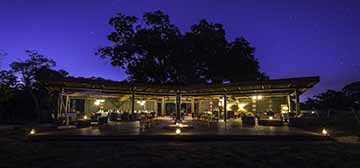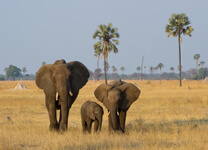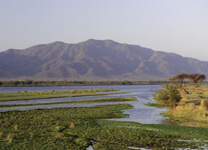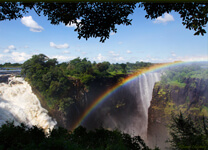
Davison's Camp
- Hwange, ZimbabweNestled discreetly beneath a grove of false mopane trees, the remote Davison's Camp is found in the private Linkwasha Concession – one of the most prolific wildlife areas in Hwange National Park.

Zimbabwe is a landlocked country situated between two great rivers: the mighty Zambezi cuts along its northern frontier, forming the border with Zambia, while the languid Limpopo forms the southern border with South Africa. In between, the country has a variety of habitats, from the granite hills of the Matopos to the majestic mountains, lush forests and beautiful rivers of the Eastern Highlands. As such, there is much to attract the traveller, from wildlife viewing and adrenalin adventures to encountering the history of the Zimbabwean people going back thousands of years.
Things to look forward to in Zimbabwe:It is in the unspoilt northern parks that we concentrate our safari operations. Mana Pools National Park, located on the Zambezi River, offers superb wildlife viewing and vistas. Along the Botswana border, Hwange National Park is home to some of southern Africa’s last great elephant, buffalo and sable herds. Finally, the Zambezi River has spectacular scenery as well as one of the world's natural wonders: the Victoria Falls.
Hwange is Zimbabwe’s largest and most popular national park where our Makalolo and Linkwasha concessions offer some of the best game viewing in Africa.

The National Parks along the Zambezi are legendary; our concession lies in Mana Pools, located on the floodplains of Africa's Great Rift Valley and offering superb wildlife viewing.

At 1 708 metres wide, Victoria Falls is the most expansive curtain of water in the world. Its neighbouring town, of the same name, is Wilderness’ operational base for Wilderness Touring, offering adventures and experiences in Zimbabwe and Zambia.

The most accessible area of the Zambezi Valley is the stretch from just above Victoria Falls all the way to the Indian Ocean. The valley itself and the river that flows through it form the border between Zambia and Zimbabwe. This entire area comprises some of the most stunning wilderness anywhere in Africa. With spectacular scenery and abundant wildlife it is no wonder that this has been one of the premier game viewing areas in southern Africa forever.
Scientists today agree that at one time the Zambezi flowed south through Botswana passing through the area of the Makgadikgadi Pans and joining up with the Limpopo river to the south. However the cataclysmic eruption which resulted in the formation of the Great Rift Valley also changed the course of the Zambezi to roughly the path it follows today. Many national parks and wildlife areas exist along the Zambezi Valley and between water activities, land based game driving and bush walks, there is something for everyone in this wonderful region.

Zimbabwe sits at the crossroads of the northern tropics of Central Africa and the southern temperate zone of South Africa. Its more than 5 000 species of flowering plants and ferns are testament to the diversity that is possible in a relatively small country at such a meeting place. The Zambezi River traces the northern border of the country flowing into Lake Kariba and then through the hot low-lying Zambezi Valley and the World Heritage Site of Mana Pools National Park, providing water year round for all manner of wildlife and waterfowl in the dry season.Large concentrations of buffalo and elephant are found along the river’s edges, while predators such as lion, wild dog and leopard are often sighted. Kudu, zebra, impala and waterbuck feed on the surrounding plains and hippo and crocodile are also numerous.
Along the Botswana border the easternmost tongues of the Kalahari sands creep into the country and mix with the teak forests of the interior. Here Zimbabwe’s largest national park, Hwange, is home to some of southern Africa’s last great elephant, buffalo and sable herds and plays an integral role in a network of southern African conservation areas. The large numbers of animals all year round – elephant, buffalo, sable, roan, giraffe, wildebeest, impala and even gemsbok – are followed by their predators: lion, leopard, wild dog and cheetah, along with African wildcat, serval, honey badger, civet and spotted hyaena.
The two areas in which we are present in Zimbabwe generally adhere to the same seasons, with one difference: Ruckomechi Camp in Mana Pools is only operational in the dry season – from April to November. In both, and throughout the year, a wealth of wildlife can be found. Below are a few helpful highlights of each time of year in Hwange and Mana Pools respectively.
Summer rainfall brings the plains of Hwange to life, with grazing animals and birds in equal abundance. This is the time of births – synchronised antelope births from impala to zebra – and arrivals – of migratory birds from far away. Incredible green season big game viewing with substantial herds of zebra, wildebeest, eland, waterbuck and impala on Ngamo Plains, together with giraffe, lion, buffalo and elephant.
Ruckomechi Camp is closed during this period.
This is the onset of the dry season – the grass is dwindling, pans are drying out and vegetation is getting thinner.As a result large mammals are drawn to the remaining waterholes and the large elephant herds filter back into the area to be seen more regularly.Water-dependent herbivores like buffalo, zebra and even kudu, sable and roan are drawn from the woodlands into the open vleis of the concession where the remaining water is situated.
Cooling temperatures herald the beginning of this season. Most of the summer rains are essentially over and it’s a great time to get into the concession and ‘rediscover’ it after a period without guests. The environment is still relatively lush and green and several intra-African migrant birds are still present. As the inland water dries out, wildlife is drawn to the floodplains of the Zambezi River near Ruckomechi Camp to drink.
This is the time to catch those iconic wildlife sights for which Hwange is renowned. With no rain, an endless procession of large herds of elephant and other impressive wildlife concentrations are found at the waterholes. Dry grass and leafless trees mean that game in general is easier to see – for example, predators like lion. Birding is equally productive with many resident specials such as Arnot’s chat and Bradfield’s hornbill.
Mana Pools National Park (June to 15 November)The initial months have a moderate, dry climate, while October and November can be very hot. Each ensuing month becomes progressively drier as all wait for the summer rains.The Zambezi floodplain is the place to be, attractingever larger, more permanent concentrations of game like elephant, buffalo, zebra, impala, waterbuck, warthog, kudu and eland – magnets for the predators. Hippo can be found at their highest densities in the river at this time.Birding is good with specials like African skimmer and Lilian’s lovebird easily picked up.